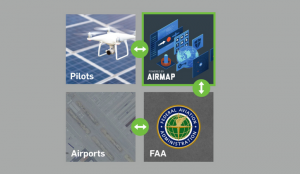
The LAANC system “will ultimately provide near real-time processing of airspace authorization requests for unmanned aircraft (UAS) operators nationwide,” says the FAA. “The system is designed to automatically approve most requests to operate in specific areas of airspace below designated altitudes.”
Designed to remove a major problem for both FAA and drone operators, the launch of the system has been eagerly awaited. FAA petitioned the Office of Management and Budget earlier this fall to expedite implementation of the prototype system forward, due to the strain that both operators and the agency experience in trying to process the high volume of authorization applications.
“Under the FAA’s small drone rules – formally known as Part 107 – operators need to secure approval from the agency to operate in any airspace controlled by an air traffic facility. LAANC is the first application developed by industry in response to this operational need,” says the announcement.
“LAANC uses airspace data provided through the UAS facility maps The maps show the maximum altitude around airports where the FAA may authorize operations under Part 107. LAANC gives drone operators the ability to interact with the maps and provide automatic notification and authorization requests to the FAA.”
Not only could the system eliminate the authorization bottleneck, but FAA says that it demonstrates progress on drone integration. “LAANC is the first UAS tool that delivers drone information to air traffic control and is the first step in developing Unmanned Aircraft Systems Traffic Management System (UTM),” says the agency.
The FAA article comes several weeks after providers Skyward and AirMap announced that the system was available for testing. These early announcements were the source of a controversy in the industry, as competitors not involved in the initial testing committee claimed that the companies were taking an unfair advantage of their unique position to gain an early market advantage. In yesterday’s article, the FAA addresses one concern of other drone operations platform providers by stating that “Two agency-approved companies, AirMap and Skyward, are currently providing LAANC services. During the evaluation, the FAA may sign agreements with additional providers who responded to the original request for information.”
FAA also said that the prototype evaluation was scheduled to last until the Spring of 2018, and would be followed by a “national Beta test,” and indicated that they would actively seek additional participants. “The agency also plans to solicit participation from new industry partners at a later date,” says the article.
Regardless of who provides the service to drone operators first, the LAANC program offers significant potential to remove a major barrier for the commercial drone industry. For updates on the prototype, visit the FAA UAS Data Exchange.

Miriam McNabb is the Editor-in-Chief of DRONELIFE and CEO of JobForDrones, a professional drone services marketplace, and a fascinated observer of the emerging drone industry and the regulatory environment for drones. Miriam has penned over 3,000 articles focused on the commercial drone space and is an international speaker and recognized figure in the industry. Miriam has a degree from the University of Chicago and over 20 years of experience in high tech sales and marketing for new technologies.
For drone industry consulting or writing, Email Miriam.
TWITTER:@spaldingbarker
Subscribe to DroneLife here.